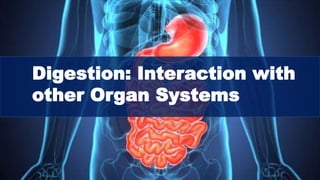
Digestion and Interaction with Other Organ Systems
- 1. Digestion: Interaction with other Organ Systems
- 3. Directions: Write the letter of the correct answer . Write your answer on your answer sheet.
- 4. What happens to the food in your small intestine? A. Mechanical digestion happens B. Water is absorbed C. Undigested food is stored D. Final digestion occurs
- 5. How does the food moves through the digestive tract? A. By gravity B. By cilia C. Chemical absorption D. Wavelike muscle contraction
- 6. Bile is stored and concentrated in the A. Gall bladder B. Urinary bladder C. liver D. Pancreas
- 7. Which of the following best maintain intestinal health? A. Fatty food B. fiber C. starch D. vitamin
- 8. Which of the following is a tube which connects the mouth and stomach? A. Trachea B. Larynx C. Esophagus D. pharynx
- 9. After going through this module, you are expected to: 1. Illustrate how ingestion, absorption, assimilation, and excretion take in the interaction of digestive system with the circulatory, respiratory and excretory systems. 2. practice moderation and healthy lifestyles
- 11. Directions: Dance with the music and answer the guide questions that follow.
- 13. A.Compare the rate of your breathing before and after exercise. B.What have you noticed with your body after the exercise? C.Did you sweat out or perspire? D.Do you need to drink water after the exercise? E.What do you think are the organ systems involved as you performed this activity?
- 14. The human body contains trillions of cells, 78 different organs and more than 60,000 miles of blood vessels if you stretched them end-to-end. Incredibly, all of these cells, vessels and organs work together to keep you alive.
- 15. Every cell in the body needs energy to perform its duties and stay alive. Cells use energy when they have the nutrients they need to perform. The digestive system converts bulk foods like bread and meat into their simple components, and absorbs them into the bloodstream through the intestines. The circulatory system moves the nutrients from the intestines to the cells that need them.
- 16. The respiratory system provides the oxygen necessary for cells to metabolize, and the circulatory system moves the oxygen around the body and to the cells.
- 17. The excretory system and respiratory system both get rid of waste products. The excretory system disposes of all food not absorbed by the body, and any foods that the digestive system couldn't break down.
- 18. What do you feel when you are hungry?
- 19. When the stomach is empty and blood glucose levels are low, the digestive system receptors and the brain respond by making you feel hungry—your stomach may “growl,” and you may feel pain or discomfort in your midsection.
- 20. Your blood also carries oxygen inhaled by the lungs. Your circulatory system delivers oxygen and nutrients to the other cells of your body then picks up any waste products created by these cells, including carbon dioxide, and delivers these waste products to the kidneys and lungs for disposal.
- 21. The circulatory system carries hormones from the endocrine system, and the immune system’s white blood cells that fight off infection.
- 22. Each of your body systems relies on the others to work well. • Your respiratory system relies on your circulatory system to deliver the oxygen it gathers, while the muscles of your heart cannot function without the oxygen they receive from your lungs. • The bones of your skull and spine protect your brain and spinal cord, but your brain regulates the position of your bones by controlling your muscles. • The circulatory system provides your brain with a constant supply of oxygen-rich blood while your brain regulates your heart rate and blood pressure.
- 23. Another example, the cardiovascular, urinary, and lymphatic systems all help the body control water balance. The cardiovascular and lymphatic systems transport fluids throughout the body and help sense both solute and water levels and regulate pressure.
- 24. Which system in your body is the most important for you? Why?
- 26. Directions: Summarize the vital role and purpose of each organ system by completing this table.